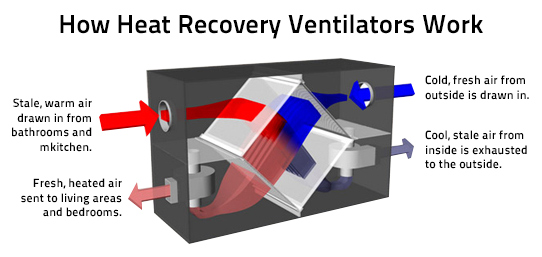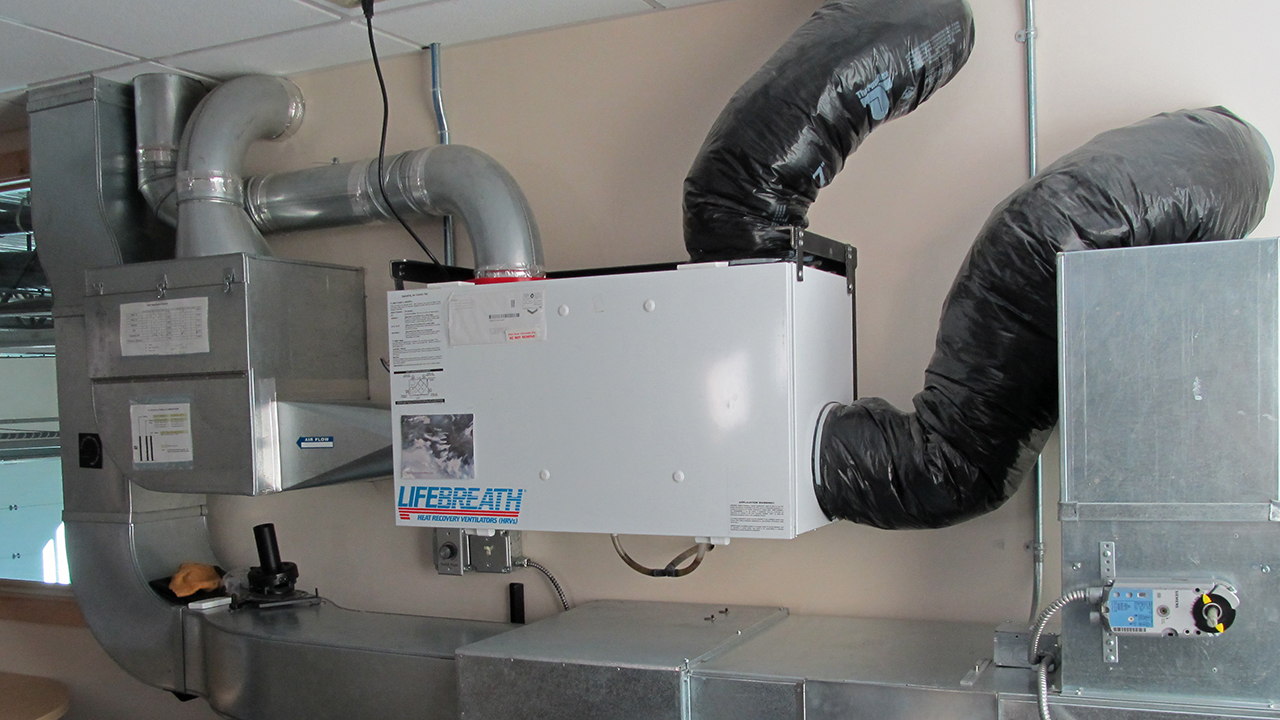The Definitive Guide to HRV Integration in Residential Spaces
Wiki Article
Revealing the Trick Conveniences and Uses of Heat Recovery Ventilation in Sustainable Design
Heat Recovery Ventilation (HRV) systems play a necessary function in sustainable design. They facilitate a continual exchange of stale indoor air with fresh exterior air, substantially boosting interior air quality. In addition, HRVs add to energy efficiency by reclaiming warmth from tired air, which can lower energy costs. Comprehending the multifaceted benefits and applications of HRVs reveals their relevance in contemporary style. What other advantages do these systems offer in the quest of sustainability?Recognizing Heat Recovery Ventilation Systems
Heat recovery ventilation (HRV) systems are made to enhance interior air quality while reducing power loss. These systems utilize a mechanical air flow strategy to exchange stale interior air with fresh exterior air, making sure a continual supply of clean air. By capturing warm from the exhaust air, HRVs prerequisite incoming air, minimizing the need on heating and cooling systems. This process not only enhances thermal convenience but likewise adds to power efficiency in domestic and business buildings. Additionally, HRV systems assist control moisture degrees and minimize interior contaminants, advertising a much healthier living environment. Their tactical implementation is necessary for achieving sustainable layout objectives, as they offer a balance in between power preservation and owner health.How HRV Systems Work
While many might be familiar with ventilation systems, understanding exactly how warm recovery air flow (HRV) systems operate is important for valuing their benefits. HRV systems work by trading stagnant interior air with fresh outside air while moving heat between the 2 streams. This process occurs in a warmth exchanger, where warmth from the outbound air warms the incoming air during cooler months, minimizing power loss. Alternatively, in warmer months, the system can cool inbound air utilizing the cooler outbound air. HRVs are equipped with fans to facilitate airflow and filters to get rid of particulates, ensuring a continuous, well balanced air flow procedure. This ingenious design not only boosts power effectiveness but also adds to preserving a comfortable indoor setting.Enhancing Indoor Air High Quality
Interior air quality can significantly impact wellness and health, making efficient ventilation essential in modern homes. Heat Recovery Ventilation (HRV) systems play a vital role in keeping indoor air quality by constantly exchanging stagnant interior air with fresh outdoor air. This procedure not only lowers airborne toxins however also decreases moisture levels, which can lead to mold growth and respiratory system problems. HRV systems filter incoming air, removing irritants and particulates, thereby offering a much healthier living environment. In addition, these systems assist eliminate odors and unpredictable organic substances (VOCs) commonly located in household items. By ensuring a regular flow of tidy air, HRV systems contribute to an overall improved indoor ambience, promoting comfort and well-being for passengers.Power Effectiveness and Expense Financial Savings
Energy performance stands apart as a significant benefit of Heat Recovery Ventilation (HRV) systems. By catching and recycling the warmth from exhausted indoor air, HRVs lessen the power required for home heating inbound fresh air, bring about reduced energy intake. This performance converts into reduced utility costs, providing substantial expense financial savings for home owners and companies alike. Furthermore, HRV systems usually receive energy performance incentives and rebates, even more improving their monetary charm. In time, the preliminary investment in HRV innovation can cause a favorable return on investment through decreased energy expenditures. The combination of HRV systems not only promotes lasting layout however also provides a sensible remedy for accomplishing long-lasting power cost savings and financial advantages.Ecological Benefits of HRV

A plethora of environmental advantages arises from the application of Heat Recovery Ventilation (HRV) systems. By effectively moving warmth from exhaust air to incoming fresh air, HRVs significantly minimize the energy required for heating and cooling rooms. This power performance converts to reduce greenhouse gas discharges, adding to a decline in the total carbon impact of buildings. In addition, HRV systems improve indoor air top quality by continuously distributing fresh air, consequently reducing the concentration of interior contaminants and irritants. The reduction in power usage help in conserving all-natural resources, making HRVs a necessary part of sustainable style. In general, the ecological advantages of HRVs play an important role in advertising a healthier world and promoting environment-friendly building practices.
Versatile Applications in Modern Style
Heat recovery ventilation (HRV) systems are increasingly being incorporated right into both domestic and business architectural projects. In household settings, HRVs improve interior air quality while making the most of power effectiveness. In commercial areas, these systems maximize air flow methods, showing their versatility in contemporary architectural applications.Residential Projects Assimilation
While modern-day architecture progressively stresses sustainability, the integration of heat healing ventilation systems in property jobs has actually become a functional option for enhancing indoor air high quality and energy effectiveness. These systems effectively move warmth from exhaust air to inbound fresh air, minimizing power loss and reducing home heating or cooling down demands. In new builds and retrofits alike, heat recovery ventilation can be perfectly incorporated, supplying homeowners with a much healthier living setting while lowering energy prices. In addition, with raising recognition of ecological effects, even more engineers and contractors are identifying the long-term advantages of these systems. Consequently, warmth recovery ventilation has actually ended up being a crucial element of sustainable residential layout, showcasing versatility and commitment to green techniques.Business Rooms Optimization
As modern commercial areas advance to meet the needs of sustainability and performance, the execution of heat healing air flow systems arises as an essential method for enhancing interior environments. These systems facilitate the exchange of stagnant interior air with fresh outside air while redeeming warm energy, substantially lowering energy consumption. This not only improves comfort for occupants however also assists in reducing functional prices. Flexible applications can be observed in these details workplaces, retail areas, and schools, where air quality and temperature control are paramount. In addition, incorporating warm recuperation air flow aligns with environment-friendly structure qualifications, further promoting ecological duty. Ultimately, adopting such systems in commercial style not only adds to sustainability objectives however additionally fosters much healthier, more productive areas for individuals.
Incorporating HRV Into Sustainable Layout Practices
Incorporating warmth recovery ventilation (HRV) systems into lasting style practices supplies substantial benefits in power performance and interior air quality. By utilizing HRV, developers can produce economical services that not just lower energy usage but likewise enhance the total comfort of indoor settings. This alignment with sustainability objectives placements HRV as an important element in modern Visit This Link architectural methods.
Power Performance Enhancement
By incorporating warmth recuperation air flow (HRV) systems into sustainable layout methods, architects and home builders can considerably enhance energy performance in modern-day constructions. HRV systems work by catching warmth from outward bound stagnant air and transferring it to incoming fresh air, reducing the power needed for heating or cooling down interior spaces. This procedure not only minimizes dependence on typical cooling and heating systems however likewise reduces general power consumption. Additionally, HRV systems can help keep a consistent interior temperature, reducing peak power demands. By incorporating these systems, structures can achieve considerable reductions in energy expenses and carbon footprints, aligning with sustainability goals. Eventually, HRV technology stands for a sensible solution for enhancing power performance in the constructed atmosphere, promoting even more liable resource usage.Indoor Air Quality Improvement
Exactly how can heat recovery air flow (HRV) systems add to exceptional interior air high quality in contemporary buildings? HRV systems successfully exchange stagnant indoor air with fresh outdoor air while recovering warm power, lessening temperature changes. This process lowers the concentration of indoor toxins, such as volatile organic substances (VOCs), allergens, and moisture, which can degrade air high quality and effect resident health. By maintaining excellent moisture levels and ensuring a constant supply of tidy air, HRVs help produce a healthier interior environment. In enhancement, these systems can be integrated into sustainable layout practices, advertising energy effectiveness along with improved air top quality. HRV Heat Recovery Ventilation. Consequently, HRV technology plays a crucial duty ahead of time general owner convenience and wellness in contemporary architectural layoutsCost-Effective Layout Solutions

Regularly Asked Concerns
What Maintenance Is Needed for Heat Recovery Ventilation Solutions?

Upkeep for heat recuperation ventilation systems normally includes normal filter replacements, cleansing of heat exchangers, assessment of fans and air ducts, and ensuring proper water drainage. These tasks assist keep performance and lengthen the system's lifespan in time.
Can HRV Equipments Be Installed in Existing Buildings?
Heat recovery ventilation systems can indeed be installed in existing buildings. HRV Heat Recovery Ventilation. Retrofitting calls for careful preparation and analysis of the building's layout, ensuring compatibility with existing systems while making the most of energy performance and interior air qualityExactly How Do HRV Equipment Influence Noise Levels Inside?
HRV systems can affect interior noise degrees by presenting audio from external resources through air flow. High-quality installations typically integrate sound-dampening functions, lessening sound influence while giving efficient air exchange and keeping convenience indoors.Exist Any Kind Of Drawbacks to Making Use Of HRV Equipments?
The disadvantages of utilizing HRV systems consist of potential high preliminary expenses, maintenance obstacles, and the possibility of reduced indoor air high quality if filters are not regularly transformed, which could lead to problems with moisture levels.Exactly how Do I Pick the Right HRV System for My Needs?
Picking the ideal warmth recovery ventilation system involves examining particular needs, such as building size, climate, and power performance goals. Additionally, evaluating system features, setup requirements, and upkeep considerations is crucial for peak efficiency and fulfillment.Report this wiki page